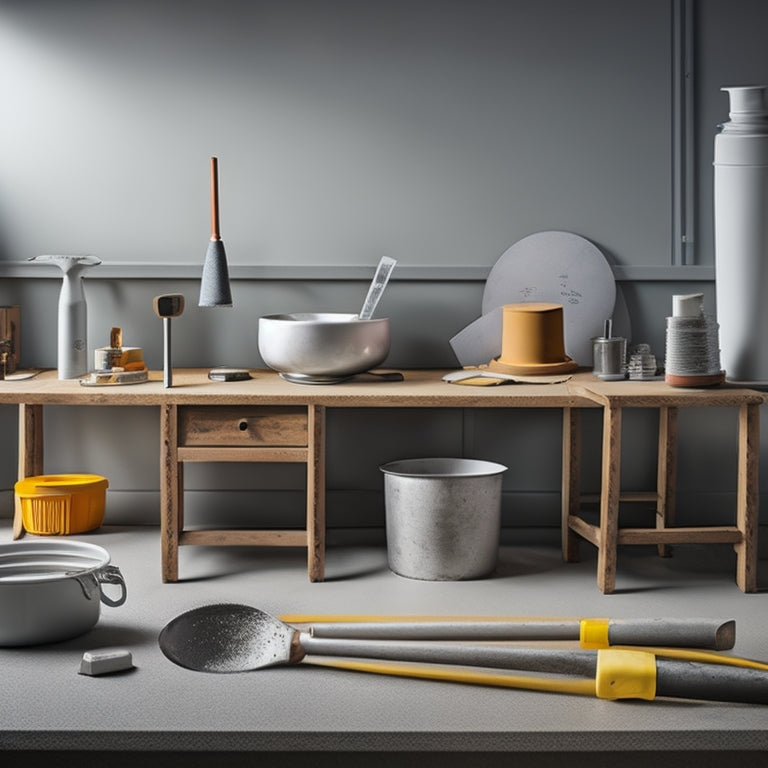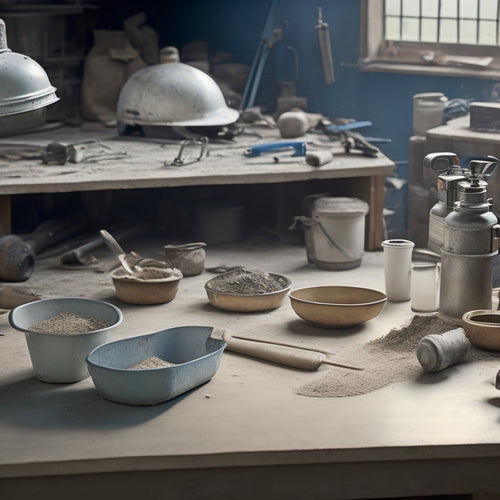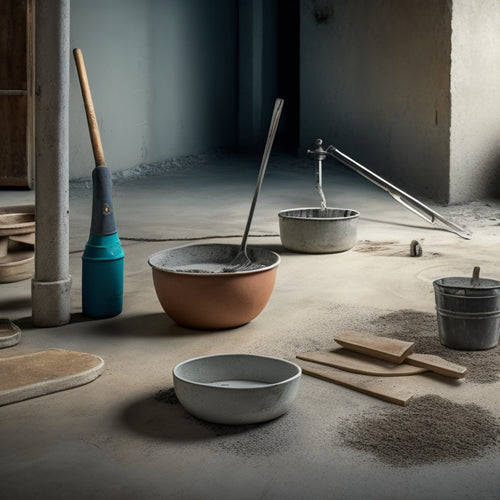
What Tools Do You Need for Quality Concrete
Share
To guarantee high-quality concrete, you'll need an extensive range of specialized tools and equipment. Start with essential safety gear like personal protective equipment, foot and head protection, and hearing protection to safeguard yourself and others on the job site. Next, invest in mixing and measuring tools, including accurate measuring cups and concrete mixing drums, as well as power mixers with safety features. Don't forget concrete finishing essentials like tamping, edging, and jointing tools, along with formwork and molding tools to shape and hold the concrete. From there, you'll want to explore compaction and vibration tools, leveling and alignment instruments, and curing and sealing tools to protect the concrete. The right reinforcement and anchors, quality control equipment, and testing tools will also be vital in achieving the desired results. Stay tuned to uncover the specifics of each tool and how they contribute to producing high-quality concrete.
Key Takeaways
• Essential safety gear like PPE, foot and head protection, and hearing protection ensures a safe working environment for quality concrete.
• Accurate measuring cups and mixing drums are crucial for achieving the right concrete mix proportions and strength.
• Concrete finishing tools like tamping tools, edgers, and jointing tools help achieve a smooth, even, and durable concrete surface.
• Compaction and vibration tools, such as hand tampers and plate compactors, remove air pockets and ensure proper compaction.
• Reinforcement and anchoring tools, including steel rebar and anchor bolts, provide structural strength and stability to the concrete.
Essential Safety Gear
When working with concrete, you must wear essential safety gear to protect yourself from the hazards of cement, aggregate, and other materials that can cause serious injuries or illnesses.
You're not just protecting yourself; you're also meeting safety regulations that are in place to prevent accidents. The right protective equipment can mean the difference between a safe job site and a hazardous one.
Start with the basics: gloves, safety glasses, and a dust mask. These will shield you from skin irritation, eye damage, and respiratory problems.
Steel-toed boots and a hard hat are also must-haves, as they'll protect your feet and head from heavy objects and falling debris.
Don't forget about earplugs, which will reduce the risk of hearing loss from loud machinery.
Make sure your equipment is in good condition and properly fitted to guarantee maximum protection.
Mixing and Measuring Tools
When you're working with concrete, you know that precise measurements and thorough mixing are essential.
You'll need the right tools to get the job done, and that's where accurate measuring cups, concrete mixing drums, and power mixers come in.
Accurate Measuring Cups
You rely on accurate measuring cups to confirm the correct proportions of cement, aggregate, and water in your concrete mix, as even slight deviations can greatly impact the final product's strength and durability.
To achieve accurate measurements, it's vital to use measuring cups that are specifically designed for concrete mixing. These cups typically have clear markings and are made of durable materials that can withstand the rigors of repeated use.
When using measuring cups, it's important to employ correct measuring techniques. This includes scooping ingredients into the cup rather than pouring them, as pouring can lead to uneven distribution and inaccurate measurements.
Additionally, make sure to level off the ingredients in the cup to guarantee precise measurements.
Concrete Mixing Drums
With accurate measurements in hand, you'll need a reliable concrete mixing drum to combine and blend the ingredients into a uniform, workable mix.
There are various concrete drum types to choose from, including steel, polyethylene, and fiberglass drums. Each type has its own advantages and disadvantages, so it's vital to select the right one for your specific needs.
When selecting a concrete mixing drum, consider factors such as durability, rust resistance, and ease of cleaning. A well-maintained drum is critical for producing high-quality concrete.
Regular maintenance tips include cleaning the drum after each use, inspecting for signs of wear and tear, and applying a rust-inhibiting coating to steel drums.
Proper maintenance guarantees your drum remains in good condition, reducing the risk of contamination and batch inconsistencies. Additionally, a clean drum helps prevent the formation of lumps and uneven textures in the concrete.
Power Mixers Essentials
Selecting the right power mixer is vital to achieving uniform, high-quality concrete mixes, as it enables efficient blending and aerating of the ingredients.
You'll need to take into account the type of power mixer that suits your specific needs, as there are various types, including electric, gasoline, and hydraulic-powered mixers. Each type has its own advantages and disadvantages, so it's important to choose the one that fits your project requirements.
When selecting a power mixer, keep the following essentials in mind:
-
Choose the right power mixer type: Take into account the size of your project, the type of concrete you're working with, and the power source available.
-
Check the mixer's capacity: Verify the mixer can handle the volume of concrete you need to mix.
-
Look for safety features: Opt for a mixer with safety features such as emergency stop buttons and protective guards.
-
Plan for mixer maintenance: Regularly clean and maintain your power mixer to prevent wear and tear.
-
Consider the noise level: If you're working in a residential area, choose a mixer with a lower noise level to minimize disruptions.
Concrete Finishing Essentials
As you move on to the final stages of concrete construction, you'll need the right tools to guarantee a smooth, even finish.
You'll be working with concrete that's still fresh and pliable, so it's vital to have the essentials on hand to shape, smooth, and finish the surface.
In this section, you'll learn about the must-have tools for tamping, edging and jointing, and smoothing and finishing your concrete project.
Tamping Tool Essentials
You'll need a reliable tamping tool to confirm your freshly poured concrete is evenly distributed and compacted, preventing air pockets and structural weaknesses. This significant step guarantees a strong, durable, and long-lasting concrete surface.
To achieve ideal results, it's vital to master various tamping techniques, such as using the correct amount of force and making smooth, even strokes.
Here are the tamping tool essentials you should consider:
-
Tamping rod: A sturdy, durable rod with a flat or rounded end, ideal for compacting concrete in tight spaces and corners.
-
Hand tamper: A handheld tool with a flat or curved blade, perfect for small areas and detail work.
-
Plate tamper: A large, flat plate attached to a handle, designed for compacting large areas quickly and efficiently.
-
Vibratory tamper: A tool that uses vibrations to compact concrete, reducing the risk of air pockets and structural weaknesses.
-
Tamping material: A specialized material, such as a rubber or plastic tamper, designed for specific tamping techniques and applications.
Edging and Jointing
Frequently, edging and jointing are overlooked yet essential steps in the concrete finishing process, requiring attention to detail to achieve a professional-looking, durable, and long-lasting result. You'll need to master various edging techniques and jointing methods to guarantee a seamless finish.
| Edging Tool | Jointing Tool | Purpose |
|---|---|---|
| Edger | Jointer | Create clean, defined edges |
| Groover | Chisel | Control joint width and depth |
| Tamping tool | Spreader | Compact and level concrete |
| Jointing trowel | Finishing trowel | Finish and smooth joints |
| Safety gloves | Safety glasses | Protect yourself from debris |
When edging, you'll use tools like edgers, groovers, and tamping tools to create clean, defined edges and control joint width and depth. For jointing, you'll employ jointers, chisels, and jointing trowels to finish and smooth joints. Remember to always prioritize safety by wearing protective gear, such as safety gloves and safety glasses, to prevent injuries from debris and other hazards. By mastering these edging and jointing techniques, you'll achieve a high-quality, long-lasting concrete finish that meets your project's requirements.
Smoothing and Finishing
With a well-edged and jointed concrete surface, you're now ready to focus on the final stages of the concrete finishing process, where smoothing and finishing techniques come into play. This is where you'll add the finishing touches to achieve a smooth, even, and durable concrete surface.
To get the job done, you'll need the right tools and techniques. Here are some essentials to take into account:
-
Tamping tools: Use these to compact and smooth out the concrete, removing any air pockets or imperfections.
-
Floats: These tools help to further smooth and flatten the surface, preparing it for the final finishing stage.
-
Trowels: A must-have for applying and smoothing out finishing compounds, such as sealers or coatings.
-
Edger: A specialized tool for creating a clean, defined edge around the concrete surface.
-
Power trowels: For larger areas, these machines can help you achieve a smooth, uniform finish quickly and efficiently.
Formwork and Molding Tools
Forming the foundation of a concrete structure, formwork and molding tools play an essential role in shaping and holding the concrete in place until it sets.
As you prepare to pour concrete, you'll need to select the right formwork techniques and molding materials to guarantee a strong and durable structure. You'll want to choose formwork materials that can withstand the weight and pressure of the concrete, such as plywood, steel, or aluminum. Molding materials like plastic or rubber can be used to create intricate designs or patterns on the surface of the concrete.
When selecting formwork and molding tools, safety should be your top priority. Make sure the tools you choose are designed for the specific type of concrete you're working with, and that they meet industry standards for safety and durability.
It's also vital to follow proper installation and removal procedures to avoid damage to the formwork or concrete. By choosing the right formwork and molding tools and following best practices, you can guarantee a strong and durable concrete structure that meets your needs and exceeds your expectations.
Compaction and Vibration
Once you've poured the concrete into the formwork, you'll need to confirm it's properly compacted and vibrated to remove any air pockets and excess water, allowing it to set with peak strength and durability. This significant step guarantees that your concrete structure can withstand the test of time and external forces.
To achieve ideal compaction and vibration, you'll need the right tools and techniques. Here are some essentials to get you started:
-
Hand tamper or tamping tool for compacting small areas and corners
-
Plate compactor or vibrating plate for larger areas, which uses vibration to compact the concrete
-
Vibrating screed or power screed for leveling and compacting freshly poured concrete
-
Internal vibrators or poker vibrators for compacting concrete in deep or hard-to-reach areas
-
Surface finishing tools, such as a bull float or tamping beam, to remove excess water and air pockets from the surface
Cutting and Drilling Tools
You'll need to utilize cutting and drilling tools to make precise modifications to your concrete structure, guaranteeing a precise fit and preventing costly rework. These tools are essential for creating openings, making adjustments, and accomplishing other tasks that require accuracy.
When it comes to core cutting, you'll want to invest in a high-quality core drill bit that can efficiently cut through concrete without generating excessive heat or vibration. Diamond drilling is another technique that's useful for creating precise holes and openings in concrete. This method involves using a diamond-coated drill bit that's designed to cut through concrete with ease.
To guarantee safety, always wear protective gear, including gloves, safety glasses, and a dust mask, when operating cutting and drilling tools. Additionally, follow the manufacturer's instructions and take regular breaks to avoid fatigue.
Leveling and Alignment
Accurate leveling and alignment of your concrete structure guarantee that it's even, plumb, and secure, which is critical for its overall integrity and long-term performance.
To achieve this, you'll need to master various leveling techniques and alignment methods.
To ascertain your structure is level and aligned, you'll need the following tools:
-
A spirit level or laser level to check for evenness and plumbness
-
A string line or screed board to guide your pouring and finishing
-
A leveling rod or staff to measure and adjust the height of your structure
-
A transit level or theodolite to verify angles and elevations
-
A precision straightedge or strike board to check for straightness and flatness
Curing and Sealing Tools
As you move on to the final stages of concrete construction, applying the right curing and sealing treatments is vital to protect your structure from environmental stressors and guarantee its durability. You'll need to invest in the right tools to secure a successful outcome.
Curing compounds are a must-have to prevent moisture loss and promote proper hydration. These compounds can be applied using a variety of tools, including sprayers, rollers, and brooms. It's important to choose the right type of curing compound for your specific project, as some are better suited for certain environmental conditions.
In addition to curing compounds, sealing membranes are also significant for protecting your concrete from water and chemical damage. These membranes can be applied using specialized tools, such as squeegees, rollers, and brushes.
When selecting a sealing membrane, consider factors such as permeability, adhesion, and durability. By using the right curing and sealing tools, you can make certain your concrete structure remains strong and resilient for years to come.
Remember to always follow the manufacturer's instructions and take necessary safety precautions when working with these tools.
Reinforcement and Anchors
When you're working with concrete, you know that reinforcement and anchors are critical components.
You'll need to decide on the right steel rebar options, choose the appropriate anchor bolt types, and consider the benefits of fiber mesh.
Steel Rebar Options
Your concrete project's structural integrity relies on selecting the right steel rebar options, which encompass a range of reinforcement and anchoring solutions designed to fortify your construction against various types of stress and loads.
With so many options available, it's crucial to understand the different types of rebar and their placement to guarantee your structure can withstand the forces it will be subjected to.
Here are some key considerations for your steel rebar options:
-
Rebar types: Choose from epoxy-coated, galvanized, or black rebar, each with its own corrosion resistance and durability benefits.
-
Rebar placement: Determine the best placement of rebar within your concrete to maximize its effectiveness, taking into account factors like beam depth, spacing, and cover thickness.
-
Rebar spacing: Verify proper spacing between rebar elements to prevent concrete from cracking and to maintain structural integrity.
-
Rebar sizing: Select the right rebar size to accommodate the load-carrying capacity required for your project.
-
Rebar connections: Use appropriate connections, such as lap splices or mechanical connections, to guarantee a secure and continuous rebar system.
Anchor Bolt Types
You'll need to choose the right anchor bolt type to securely fasten your structure to its foundation, guaranteeing the rebar-reinforced concrete can effectively resist external loads and stresses.
Anchor bolts are a vital component in concrete construction, as they transfer loads from the structure to the foundation. There are several types of anchor bolts, each with its own unique characteristics and applications.
Screw anchor types, for instance, are ideal for securing light to medium loads, such as shelves or equipment. They're easy to install and provide a strong holding power.
On the other hand, expansion bolt applications are better suited for heavier loads, like machinery or heavy equipment. These bolts expand when tightened, creating a strong anchor point in the concrete.
It's important to select the right anchor bolt type for your specific project to guarantee the structure's safety and stability. By doing so, you'll be able to withstand external forces, such as wind, earthquakes, or other natural disasters.
Fiber Mesh Benefits
By incorporating fiber mesh reinforcement into your concrete mixture, you can considerably enhance the structural integrity and durability of your project, while also reducing the need for traditional reinforcement methods like rebar.
Fiber mesh advantages lie in its ability to provide three-dimensional reinforcement, which helps to prevent shrinkage cracks and improve impact resistance. This makes it an ideal solution for a wide range of fiber mesh applications, from residential construction to industrial flooring.
Some of the key benefits of using fiber mesh reinforcement include:
-
Improved durability and resistance to wear and tear
-
Reduced risk of cracks and damage from impact or vibration
-
Increased structural integrity and load-bearing capacity
-
Simplified installation process, reducing labor costs and time
-
Enhanced sustainability, as fiber mesh is often made from recycled materials
Quality Control Equipment
Concrete producers rely on a range of quality control equipment to guarantee the production of high-quality concrete that meets project specifications and industry standards.
As a concrete producer, you understand the importance of quality assurance in guaranteeing the durability and safety of your final product. To achieve this, you need to invest in the right quality control equipment.
You'll need testing methods such as slump testing, compression testing, and air content testing to evaluate the properties of your concrete. Slump testing, for instance, helps you determine the workability of your concrete, while compression testing measures its compressive strength. Air content testing, on the other hand, detects the amount of air entrapped in the concrete.
Additionally, you'll require equipment for measuring temperature, humidity, and other environmental factors that can affect concrete quality. By investing in this equipment, you'll be able to identify potential issues early on and take corrective action to guarantee your concrete meets the required standards.
This not only saves you time and resources but also guarantees the safety of your final product. With the right quality control equipment, you can have confidence in the quality of your concrete.
Frequently Asked Questions
Can I Use Regular Gloves Instead of Concrete Gloves?
Can you use regular gloves instead of concrete gloves?
Not recommended. Concrete work demands specific safety precautions, and regular gloves don't cut it.
Concrete gloves are made with specialized materials that protect your hands from harsh chemicals, abrasion, and punctures.
Regular gloves won't provide the same level of protection, putting you at risk of injury.
Invest in concrete gloves to guarantee your safety on the job.
How Do I Prevent Concrete From Sticking to My Tools?
'an ounce of prevention is worth a pound of cure' - this adage rings true when working with concrete.
To prevent concrete from sticking to your tools, you'll need to focus on tool preparation and surface treatment.
Apply a release agent, such as a silicone-based spray or oil, to your tools before use. This will create a barrier, making it easier to remove concrete residue.
Additionally, guarantee your tools are clean and dry to prevent moisture from attracting concrete.
What Is the Ideal Temperature for Pouring Concrete?
When you're ready to pour concrete, you'll want to guarantee the ideal pouring temperature.
Temperature effects can greatly impact the final product. Ideally, you should pour when the air temperature is between 50°F and 80°F (10°C and 27°C). This range allows for proper curing and prevents excessive water evaporation, which can lead to weak spots.
Avoid pouring in direct sunlight or during extreme weather conditions to guarantee a safe and successful pour.
Can I Reuse Concrete That Has Already Hardened?
You're wondering if you can reuse concrete that has already hardened. The short answer is no, you shouldn't.
Hardened concrete can't be reused in its original form, but you can consider concrete recycling benefits. Crushed hardened concrete can be reused as aggregate in new mixes or as a base material in construction projects.
However, make sure you follow safety protocols and guidelines for handling and processing hardened concrete applications to avoid any potential hazards.
How Long Does It Take for Concrete to Fully Cure?
Finessing the fundamentals of concrete curing is essential.
You'll find that the curing process unfolds in stages, with varying curing times depending on environmental factors and mix design.
Typically, concrete reaches 70% strength within 7-10 days, but full curing can take up to 28 days.
Guarantee best results by maintaining a controlled environment, minimizing moisture loss, and following recommended curing protocols to achieve durable, defect-free concrete.
Conclusion
With the right tools in your arsenal, you're ready to release a concrete masterpiece.
Imagine a smooth, unblemished surface that shines like a polished gem, a tribute to your craftsmanship.
But it's not just about aesthetics - with these essentials, you'll guarantee a strong, durable structure that stands the test of time.
Now, get ready to transform raw concrete into a work of art that will leave a lasting impression.
Related Posts
-

What Tools Do You Need for Concrete Success
For concrete success, you'll need a range of essential power tools, including rotary hammers, angle grinders, concret...
-

Why These Tools Are Crucial for Concrete Patio
You're about to commence on a concrete patio project, and having the right tools is vital to achieving professional-l...
-

Why You Need These Concrete Overlay Tools
When tackling a concrete overlay project, you need the right tools to achieve a flawless finish and avoid costly mist...


